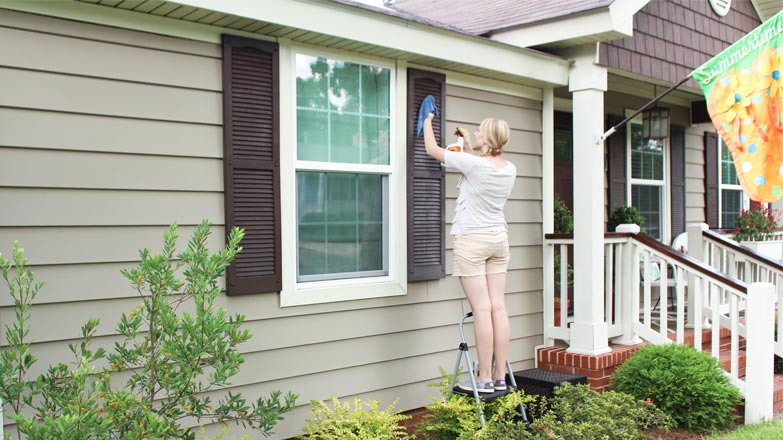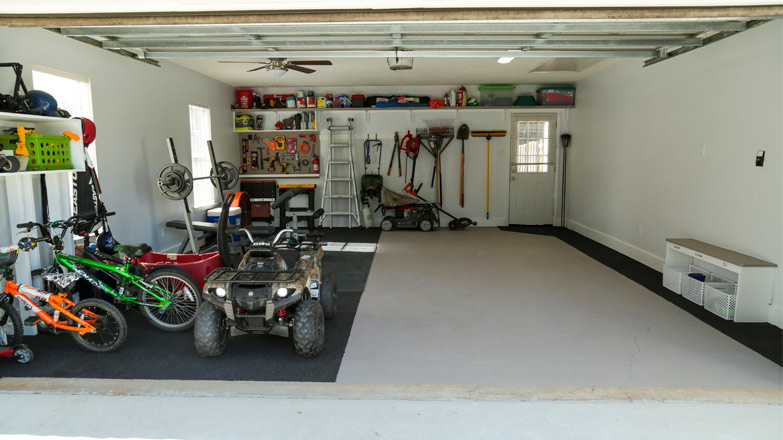Hide Your AC Unit with a Trellis
How To Build Panels to Cover your AC Unit
Call it a trellis or call it lattice, hide your AC unit with these easy DIY panels! Take it a step further and plant climbing vines to cover your HVAC even more!

Materials to Hide AC Unit
- pressure-treated 4x4s*
- post hole diggers*
- fast-setting concrete
- pressure-treated lattice strips/lath*
- nail gun*
Sure, you can get pre-made lattice panels. But to hide this particular AC unit, I wanted to mimic the ‘checkerboard’ under skirting of the deck Dad and I built for a recent episode of Today’s Homeowner. And since no where locally sells checkerboard panels, I built this one out of lattice strips.
This project was made in partnership with Exmark Mowers. My full how-to video is on their Backyard Life site along with tons of other outdoor project videos!

Set Posts at Corners
Once you decide on how many sides of your AC you’re going to conceal, you can start digging for the posts. I created a panel on the deck side and one on the yard side, so I needed (3) 4×4 posts. One for each end and one in the middle to share.
Mark your holes at least 24 inches away from your unit. This allows room for future service professionals and gives the unit adequate space for air intake. Then dig the holes with post hole diggers, about 12 inches deep.
You’ll want to have at least 1 foot of post in the ground. So measure the height of your unit and add 12 inches to it. I cut my 4×4 posts to 48″, so my panels ended up being 3 feet above the ground.
Set a post in the hole and add the fast-setting concrete around it.

Have a level handy to check for plumb as you add water to the concrete mix and it starts to harden. Work on one post at a time since it sets up so quickly!

Add Lattice Strips
The next, and arguably most important, step to hide your AC unit is the lattice! You’ll need a piece of scrap wood, maybe a few inches of a 2×4 turned up on its side, to use as a spacer block as you’re installing the strips.
I started at the top and nailed one lattice strip flush with the 4x4s on the top and on the sides. For my next strip, I pushed my spacer up against the first piece followed by the next lattice strip. This will give you uniform spacing throughout your panel.

Make sure you use your spacer on the other end too!
Keep going down your panel until it’s as low as you want. Mine stopped 5-6 inches from the ground. Then it’s time to work on the vertical strips!
Because it’s highly unlikely your panel will be equally divisible by your spacer block, you may need to fudge the vertical strips as you from outside to inside.

Start with vertical strips on each end flush with the outside of your 4×4 posts. Use the spacer block to place the next 3-4 strips on the right and left sides. Then, dry fit a few strips, with the spacer block, to see how the spacing will end up in the middle. Mark them with a pencil as you go so you have a visual guide. If you’re going to have 2 strips really close together, you’ll want to eliminate one strip and slightly increase the spacing as you move in.
I would hold up the spacer block and the next strip, then I would lower the spacer and slide the strip over 1/8 inch or so. And I would continue doing that, alternating between right and left, until the middle of the panel was full of vertical strips. It’s hardly noticeable once it’s all said and done.

This is the slight disadvantage to building lattice from scratch. If you prefer to build it with pre-made lattice panels, here is a larger-scale privacy panel project I built many moons ago!

Or I suppose you could take the length of your panel-to-be, crunch some numbers and cut a spacer block to the right width so that you could use it uniformly throughout. But I don’t have the brainpower for that!
Plants to Hide Your AC
After you’ve made your way around nailing all of the vertical strips, you can paint or stain it to match your deck or existing outdoor accents. Then take it up a notch and plant some climbing vines. They’ll grow up the lattice in no time and cover your HVAC unit even more! And it’ll probably even knock some of the noise from the unit too.
My favorites are Carolina jasmine and Bougainvillea.

Don’t forget to click over to Exmark’s Backyard Life to see my video tutorial on How to Hide Your AC Unit and many more projects!
Thanks for Checking In! Chelsea




2 Comments
Peggy Burnette
Very nice, could you use lattace ? Thanks, love your show, sorry to see your dad retire (even if he deserves it ha ha). Are you going to take over the show? Hope you do. Peggy
Chelsea Lipford Wolf
Hi Peggy! I don’t have plans to take over the show. It was a great and fun chapter but I’ve got other plans coming up! 🙂
Yes you can use lattice for this project! I’ve always got to make it hard on myself and try new things! Ha! ~Chelsea